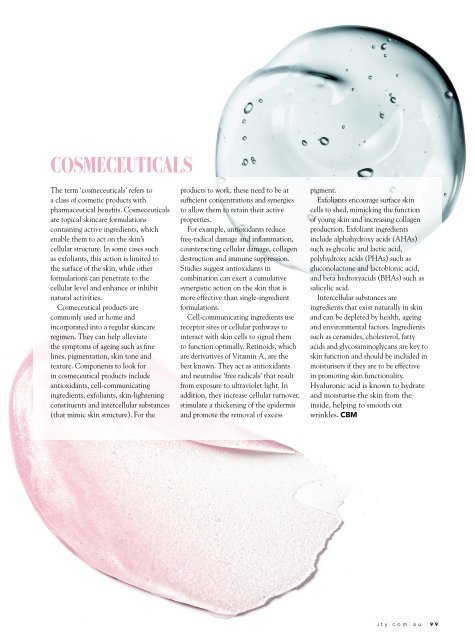CosBeauty Magazine #90
CosBeauty is the #BeautyAddict's guide to lifestyle, health and beauty in Australia and New Zealand. In this issue: - Summer Body; Meet this season's glow getters - 80+ Products to up your skincare game - 2020 Beauty lovers Christmas gift guide - Face-to-Face; the non-surgical tweakments turning heads
CosBeauty is the #BeautyAddict's guide to lifestyle, health and beauty in Australia and New Zealand.
In this issue:
- Summer Body; Meet this season's glow getters
- 80+ Products to up your skincare game
- 2020 Beauty lovers Christmas gift guide
- Face-to-Face; the non-surgical tweakments turning heads
You also want an ePaper? Increase the reach of your titles
YUMPU automatically turns print PDFs into web optimized ePapers that Google loves.
COSMECEUTICALS<br />
The term ‘cosmeceuticals’ refers to<br />
a class of cosmetic products with<br />
pharmaceutical benefits. Cosmeceuticals<br />
are topical skincare formulations<br />
containing active ingredients, which<br />
enable them to act on the skin’s<br />
cellular structure. In some cases such<br />
as exfoliants, this action is limited to<br />
the surface of the skin, while other<br />
formulations can penetrate to the<br />
cellular level and enhance or inhibit<br />
natural activities.<br />
Cosmeceutical products are<br />
commonly used at home and<br />
incorporated into a regular skincare<br />
regimen. They can help alleviate<br />
the symptoms of ageing such as fine<br />
lines, pigmentation, skin tone and<br />
texture. Components to look for<br />
in cosmeceutical products include<br />
antioxidants, cell-communicating<br />
ingredients, exfoliants, skin-lightening<br />
constituents and intercellular substances<br />
(that mimic skin structure). For the<br />
products to work, these need to be at<br />
sufficient concentrations and synergies<br />
to allow them to retain their active<br />
properties.<br />
For example, antioxidants reduce<br />
free-radical damage and inflammation,<br />
counteracting cellular damage, collagen<br />
destruction and immune suppression.<br />
Studies suggest antioxidants in<br />
combination can exert a cumulative<br />
synergistic action on the skin that is<br />
more effective than single-ingredient<br />
formulations.<br />
Cell-communicating ingredients use<br />
receptor sites or cellular pathways to<br />
interact with skin cells to signal them<br />
to function optimally. Retinoids, which<br />
are derivatives of Vitamin A, are the<br />
best known. They act as antioxidants<br />
and neutralise ‘free radicals’ that result<br />
from exposure to ultraviolet light. In<br />
addition, they increase cellular turnover,<br />
stimulate a thickening of the epidermis<br />
and promote the removal of excess<br />
pigment.<br />
Exfoliants encourage surface skin<br />
cells to shed, mimicking the function<br />
of young skin and increasing collagen<br />
production. Exfoliant ingredients<br />
include alphahydroxy acids (AHAs)<br />
such as glycolic and lactic acid,<br />
polyhydroxy acids (PHAs) such as<br />
gluconolactone and lactobionic acid,<br />
and beta hydroxyacids (BHAs) such as<br />
salicylic acid.<br />
Intercellular substances are<br />
ingredients that exist naturally in skin<br />
and can be depleted by health, ageing<br />
and environmental factors. Ingredients<br />
such as ceramides, cholesterol, fatty<br />
acids and glycosaminoglycans are key to<br />
skin function and should be included in<br />
moisturisers if they are to be effective<br />
in promoting skin functionality.<br />
Hyaluronic acid is known to hydrate<br />
and moisturise the skin from the<br />
inside, helping to smooth out<br />
wrinkles. CBM<br />
www.cosbeauty.com.au 99


















